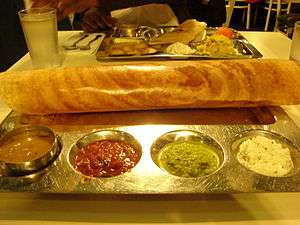Kannada people
The Kannada people or Kannadigas ("Kannadigas" is a term obtained by adding the English suffix "-s" to "kannadiga" to make it plural. "Kannadigaru" is the plural form in Kannada),[4] are speakers of Kannada language and trace their ancestry to the state of Karnataka in India and its surrounding regions.[5] Kannada belongs to the Dravidian family of languages.[6] Significant Kannada minorities are found in the Indian states of Maharashtra,[7] Tamil Nadu,[8] Andhra Pradesh, Goa[9][10] and in other Indian states.[7] An alternate English demonym for Kannadigas in modern works of history is the Kanarese.[11] Modern Kannada stands among 30 of the most widely spoken languages of the world as of 2001.[12]
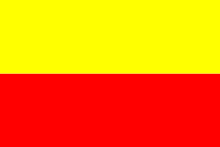 Flag of Karnataka and Kannadigas | |
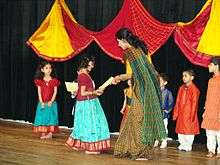 Kannadiga children in traditional dress | |
| Total population | |
|---|---|
| c. 52 million (2021)[1][2] | |
| Regions with significant populations | |
| 52 million[1] | |
| Languages | |
| Kannada | |
| Religion | |
| Majority: Minority: [3] | |
| Related ethnic groups | |
| Dravidians · Tuluvas · Konkanis · Kodavas • Telugu | |
| Part of a series on the |
| History of Karnataka |
|---|
|
| Categories |
|
Evidence for human habitation in Karnataka exists until at least the 2nd millennium BCE, and it is postulated to have had contact with the Indus Valley civilisation. The existence of artifacts (such as Roman coins) shows Karnataka was involved in trade as early as the 1st century CE. In the 4th century BCE the land was ruled by the Mauryans and Jainism was very popular. After the Mauryas, parts of Karnataka were variously ruled by dynasties either ethnically Kannadiga or outside. The Kadambas, Chalukyas and Holysalas were some of the many major Kannada kingdoms and dynasties ruling the region. The Vijayanagara Empire was founded by Kannadiga chieftains and they were great patrons of Kannada art and literature.
The Kannada language has written inscriptions since 450 CE. Kannada literature is mostly composed of poems and treatises on religious works. Kannada architecture is dominated by stone-carved sculptured palaces and temples. The ruins of Hampi are a UNESCO World Heritage site. Kannada music and dance is rich and varied, including both complex.
Most Kannadigas are Hindus, but in rural areas villagers practice Dravidian folk religion similar to their Tamil neighbours, worshipping many gramadevataru in addition to the main deities. In addition, many in North Karnataka practice Lingayatism, a religious tradition centred around worship of Shiva. There are also small minorities of Jains, remnants of ancient times and Christians. Kannada cuisine is varied, with both non-vegetarian and vegetarian items using numerous spices.
History
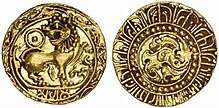
Settlement in Karnataka is found to be existent at least from the 2nd millennium BC as explored in Brahmagiri archaeological site near Chitradurga district, central Karnataka. Chandravalli exploration has revealed interaction of Roman and Chinese travelers around the 2nd and 3rd century BC.[13] Talagunda[14] and Halmidi stand as the oldest excavated inscriptions as available today.
The language was once popular from Kaveri to Godavari as mentioned in the Kannada classic Kavirajamarga of 850 CE.[15] Archaeological evidences show Kannada inscriptions found as far north as Madhya Pradesh (Inscription of Krishna III) and Bihar.[16] Karnataka Expansion provides insights to kingdoms of northern India whose originators were from Kannada country.[17]
The major empires and kingdoms, their regal capital and most distinguished kings were:
- Western Ganga Dynasty - Talakadu - Durvinita
- Kadamba Dynasty - Banavasi - Mayurasharma (Mayuravarma)
- Badami Chalukya - Badami - Pulakeshin II
- Rashtrakuta - Manyakheta - Amoghavarsha I
- Hoysala - Belur and Halebidu - Veera Ballala II
- Kalyani Chalukya - Basavakalyana - Vikramaditya VI
- Southern Kalachuri - Kalyani - Bijjala II
- Vijayanagara Empire - Hampi - Hakka, Bukka
- Keladi Nayaka - Ikkeri - Shivappa Nayaka
- Haleri Kingdom - Kodagu - Mudduraja
- Kingdom of Mysore - Mysooru - Chikka Devaraja Wodeyar
Minor dynasties that have played an important role in the development of Kannada, culture and polity were Chutus of Banavasi (feudatory to Satavahana Empire),[18][19] Tuluva Dynasty of Canara,[20] Rattas of Saundatti (Belgaum),[20] Guttas of Guttal (Dharwad region),[21] Banas of Kolar,[22] Nolambas of Nolambavadi,[23][24] Vaidumbas,[25][26] Chengalvas,[20] Kongalvas,[20] Sendrakas of Nagarkhanda (Banavasi province), Yalahanka Nadaprabhu kempegowda,[27] Sindas of Yelburga (Bijapur-Gulbarga),[21] Kadamba of Hangal.[28]
In addition, other well known kingdoms that patronized Kannadiga poets and Kannada language were:
- Eastern Chalukyas[20]
- Kakatiya dynasty[20]
- Seuna Yadavas of Devagiri[29]
- Shilahara[20]
- Kadambas of Goa[30]
Immigrants from Karnataka
In addition to those empires that ruled from the Karnataka region, based on inscriptions and literary evidence historians have discussed the possibility that kingdoms of Kannada origin were established in other parts of India as well.
- The Karnata Dynasty (founded by Nanyadeva I) of Mithila and Nepal,[16][31][32][33][34][35][36][37][38] However contrary evidence also suggests that this dynasty may have been of Parmar Rajput origin.[39][40][41][42][43]
- The Chalukyas of Gujarat,[44][45]
- The Chalukyas of Vengi (Eastern Chalukya),[44][46][47]
- The Seuna Yadavas of Devagiri,[48][49][50][51]
- The Rashtrakuta family ruling from Berar (modern Amravati district, Maharashtra),[52]
- The Rashtrakutas branch of Gujarat (Lata branch),[53][54]
- The Sena dynasty of Bengal[55][56][57]
- The Eastern Gangas of Orissa (descendants of the Western Ganga Dynasty)
Caste and Communities
Just like other Ethnolinguistic groups in india, Kannada speaking people also comprise of a number of distinct communities. The two numerically biggest communities are the Lingayat and the Vokkaliga from northern and southern parts Karnataka respectively.There are also numerous OBC (other backward communities) including the former pastoralist community of Kuruba, scheduled castes like Adi Karnataka and brahmins.[58]
Culture
Architecture

Architecture and Sculpture have been the hallmarks of art in Kurnaatuka. Be it the musical pillars of Hampi, which is listed as a UNESCO World Heritage Site,[59] the ekashila (monolithic) statue of Gommateshvura Baahubuli that was voted by Indians as the first of Seven Wonders of India,[60] the Yellu Suttina Kote of Chitradurga (The Fort of Seven Whorls) cutting across hill or the wholesomeness of carvings of temples which bared down all desires to be left out of it and formless (above all forms) all encompassing – the inner garbhagrihas. The temples of Karnataka have in them many shaili or styles. A majority of the temples were built using the locally available stones.
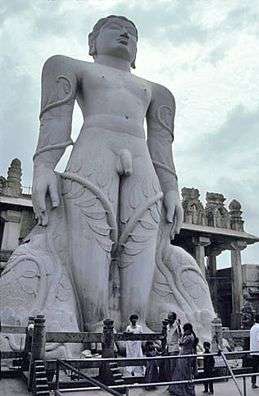
Some of the places of interest are:
- Ellora Caves houses the Kylasunaatha temple of Ellooru; it was built by the Raashtrukuta Dynasty and is declared as a World Heritage Site by UNESCO[59]
Heel Akki
- Elephanta Caves island was a summer resort of the Raashtrakuta kings and is declared as a World Heritage Site by UNESCO.[59]
- Konark Sun Temple also called Soorya Devaalaya and Black Pagoda built on the in coast of Odisha, India by Narasimhadeva I of the Eastern Gunga Dynasty is declared as a World Heritage Site by UNESCO.[59]
- Ujunta Caves have sculptures of Raashtrakutas and Badami Chaalukyas and is declared as a World Heritage Site by UNESCO.[59]
- Hampi houses the ruins of the Vijayanagara Empire and is declared as a World Heritage Site by UNESCO[59]
- Puttudukullu is a vesura style of Hindu temple architecture, a UNESCO World Heritage Site[61]
- Baadaami cave temples, a regal capital of the Baadaami Chaalukyas, now famous for its sandstone cave temples[62]
- Aiholle is known for its many temples[63] and inscriptions of Chaalukya Pulakeshin II in the Old Kannada script[64]
- Basavakalyana, a major center of social and religious movement in the 12th century by Basava, consists of temples in Chaalukya architecture[65]
- Itugi is home to the Shiva temple built by Vikramaaditya. Considered to be the best specimen of Kulyaanni Chaalukyun art, it has 68 decorated pillars, an ornate tower and a doorway of great workmanship[66]
- Lukkundi
- Belooru
- Hallebeedu
- Shraavunnabellugolla
- Soumyakeshuva Temple, Naagumungulla
- Lakshmeenaaraayunna Temple, Hosuhollulu
- Mullikaarjuna Temple, Basarallu
- Ikkeri
- Keludi
- Bunuvaasi
The sculptors were:
- Umurushilpi Jukunnaachaari
- Ruvaari Malithumma
- Chaavunduraaya
- Siddulinguswaami
- K. Venkatuppa
Modern day contemporaries include visionary architects such as:
- Mokshagundum Vishveshvuruyya, Father of Modern Indian Engineering and architect of Kunnumbaadi Katte (or Krushnaraajusaagura Dam)
- Kengul Hunumuntuyya, Vidhaana Soudha
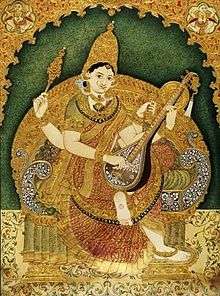
Modern Kannada art is primarily influenced by Raja Ravi Varma and his realism. Popular visual arts generally revolve around puppetry. Most traditional religious paintings are very colorful.
These are many of the places where art is displayed.
Music
Dasa sahitya is the literature of Bhakti movement composed by devotees in honor of Lord Vishnu or one of his avatars. Dasa is literally "servant" in Kannada and sahitya is literature. Haridasas ("servants of God") were preachers of Bhakti to Vishnu. The bhakti literature of these Haridasas is collectively referred to as Dasa Sahitya. It is composed in the Kannada language.[67]
The Haridasas richly contributed to the heritage of Karntataka music.[67][68] They made an indelible impression on the religious and cultural life of Karnataka by spreading the didactic teachings in a musical form to the hearts of the common folk.[69] Like other doyens of Indian classical music, these scholars offered prayer to Vishnu through music, called naadopasana. The Lord is described as Samagana priya, and bhakti through music is the most preferred path to 'reach' Him.[70]
The Haridasa compositions are popularly known as Devaranamas. Compositions like Krishna Nee Begane Baaro, Venkatachala Nilayam, Jagadoddharana, Tamboori Meetidava are some of the many examples of their scholarly work.
.jpg)
Some noted Haridasas or composers of Dasa Sahitya are:
- Purandara Dasa, widely regarded as Karnataka Sangeeta Pitamaha or "Father of Carnatic music"[71]
- Kanaka Dasa, a younger contemporary of Purandara Dasa
- Sripadaraja
- Vyasatirtha
- Vadirajatirtha
- Jagannatha Dasa
- Jayatirtha
- Gopala Dasa
- Vijaya Dasa
- Naraharitirtha
One of the oldest forms of music in the region is Karnataka Shastreeya Sangeetha which has evolved over ages. Both Hindustani and Karnataka variations are respected and nurtured by Kannadigas. Bhavageete and Sugama Sangeetha are some innovations. Other forms of music include Gamaka,[72] Joogera Pada and Lavani.[73] Yakshagana is considered a unique and indigenous form of both music and dance of Karnataka.[74]
Contemporary musical thespians are:
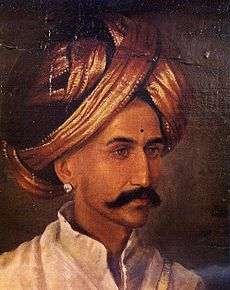
- Pandit Bhimsen Joshi, recipient of the Bharat Ratna — India's highest civilian honor[75]
- Gangubai Hangal, awarded both Padma Bhushan and Padma Vibhushan in 1971 and 2002 respectively[76]
- C. Aswath, recipient of Karnataka Rajyotsava Prashasti for his immense contribution to Bhavageete[77]
- Veene Doraiswamy Iyengar
- Puttaraj Gawai
- Honnappa Bhagavathar
- P. Kalinga Rao
- Balappa Hukkeri
- Mallikarjuna Mansur
- Basavaraja Rajguru
- Veene Sheshanna
- T. Chowdiah
- Sawai Gandharva
- Kumar Gandharva
- Mysore Ananthaswamy
- Mysore Manjunath
Theater
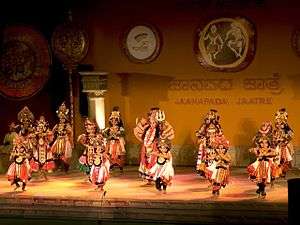
Rangabhoomi or the theater culture is a tradition with Kannadigas. While a lot of gadhya (literature) is written in praise of the heroic characters of the epics and puranas, there are major works depicting the kings and their rule. These are called Naataka (plays having wide-ranging stages for performance like Rangamancha staged in either theaters or on streets) and Bayalata (ಬಯಲಾಟ).[78] As its etymology indicates, bayalu means open-air field and ata means theater. In southern Karnataka, the eastern and western varieties of Yakshagana are termed Bayalata, whereas in the north several other distinct genres are included under the name.[79]
Harikathe which covers an entire night is another form where one (or more) person tells a story in an outstanding manner accompanied by music at background.[80] It is a common feature to narrate battles, stories, devotions or vratha in front of temples on auspicious days like Dasara and Maha Shivaratri.[81] Harikathe is a composite art form composed of story telling, poetry, music, drama, dance, and philosophy. Today, late-night Harikathe sessions are organized overseas where Kannadiga population is considerable.[82]
Vasanta Habba (ವಸಂತ ಹಬ್ಬ), which means "spring festival" in Kannada is a cultural festival organized by the Nrityagram foundation in Bengaluru. It is a very popular event and is considered the classical Woodstock of India.[83] First held in 1990, it now attracts the best musicians, dancers and cultural artists from across India.[84] Similarly,'Bengaluru Habba (ಬೆಂಗಳೂರು ಹಬ್ಬ is a congregation of art performances at places in the city which is successfully celebrated every year. It aims to provide aesthetic entertainment to a wide cultural, social and demographic cross-section of the city's people by partnering with corporates and other stakeholders since 2003.[85] In 2006, the Government of Karnataka tried to bring the folklore and art into the city of Bengaluru by initiating Jaanapada Jaatre (ಜಾನಪದ ಜಾತ್ರೆ) which was hugely successful and received well by art lovers. It is usually held on select weekends in Lalbagh and other parts of the city.[86]
Some famous theatrical, cinematic and television personalities like T P Kailasam, Gubbi Veeranna, C. Honappa Bhagavathar, G V Iyer, Dr. Rajkumar, Puttanna Kanagal, Kalpana, B. S. Ranga, B V Karanth, Girish Kasaravalli, Shankar Nag, T.S. Nagabharana, T N Seetharam have contributed for its richness.
Dance forms
The mystic and spirited reliving of legends and epics are the major depictions in dance forms. With the theater of battle scenes of heroism, loyalty and treachery, colour and pageantry are the main subjects. More are adapted with the course of nature and seasons adding colour to the harvesting seasons. Tribal forms of dance can be found limited in the regions inhabited by Soligas, of which Pinasee is a traditional dance form.[87] The people of Kodagu in the Western Ghats also have their own dance forms.
Some of the folk dances and classical dance forms in Karnataka include:
- Dollu Kunitha, a popular drum dance accompanied by singing
- Kamsale, danced to the tune of a rhythm instrument of the same name made of brass
- Veeragase, a vigorous dance based on Hindu mythology which is demonstrated at the Mysore Dasara procession
- Yakshagana is a musical theater popular in coastal and Malenadu regions of Karnataka
- Gaarudi Gombe, where dancers adorn themselves with giant doll-suits made of bamboo sticks
- Moodalapaya
- Bayalata featuring stories of Puranas rendered as dance
Martial arts
The martial arts more prevalent in parts of North Karnataka with Garadi Mane present in every village and a head to train the youngsters into fit individuals. Kusthi, Malla Yuddha, Kathi Varase (which can be seen depicted in Veeragase and similar to sword fighting), Malla Kambha (gymnastics on a pole structure with/without rope) are some of the prominent arts practised.
The Mysore Odeyars arrange kaalaga or fights like Vajra Mushti during Dasara festival which is made less frightening these days as they are publicly staged. Rock lifting, Bull race, Kusthi, and Kabaddi are popular sports.[88]
Yogasana, Praanayama and health-related camps are very popular throughout the state and some of the best Yoga practitioners can be found here. Art of Living is one such organization immensely popular all over the world.
- Malladihalli Sri Raghavendra Swami
- K. Pattabhi Jois
Festivals
Kannadigas celebrate festivals throughout the year presenting the diverse culture and belief of the ethnicity. Festivals have varied reasons to celebrate.
- Agriculture: Upon onset of monsoon, sowing or harvest there are festivals celebrated like Chaandramana Ugaadi (marking of new year), Makara Sankranthi and Huttari.
- Monsoon: Dasara/Navarathri, Ayudha Puja, and Deepavali.
- Puraana: Maha Shivarathri, Varamahalakshmi Vrata, Bheemana Amavasye, Swarna Gowri Vratha, Ganesha Chaturthi, Naagara Panchami, Ratha Sapthami, Krishna Janmashtami, Rama Navami, Vijaya Dashami, Vaikunta Ekadashi, Naraka Chaturdashi, Bali Padyami and others.
In the countryside, a dana jaathre (livestock fair) is held which is a conglomeration of people where a local demigod is worshiped and a ratha or theru (chariots) are moved by the bhakthas and daasoha (free food) is arranged for the visitors.
North Karnataka has a unique blend of Hindu and Muslim brotherhood with people celebrating festivals in unison and exchanging goodwills owing to great revolutionary Shishunala Sharif and Guru Govinda Bhatta who had displayed their religious tolerance and spiritual unity of all religions.
Christmas is celebrated at large in Bengaluru and Mangalooru which host some of the oldest churches and educational institutions of the country. Buddha, Mahaveera, Shankara, Basavanna and Gandhi are remembered on their birth anniversaries.
Cuisine
The cuisine of Karnataka includes many vegetarian and non-vegetarian dishes. The varieties reflect influences from the food habits of many regions and communities from the three neighbouring South Indian states, as well as the state of Maharashtra to its north. Soopa Shastra is notable medieval Kannada literally work written in 1508 A.D on the subject of Kannada cuisine.[89]
Some typical everyday dishes in Kannadiga homes include Bisi Bele Bath, Jolada rotti, Ragi rotti, Akki rotti, Saaru, Huli, Davanagere Benne Dosa, Ragi mudde, Chitranna (lemon rice) and Uppittu. The famous masala dosa traces its origin to Udupi cuisine.[90] Plain and rave Idli, Mysore Masala Dosa and Maddur Vade are very popular in South Karnataka. Kadabu, a kind of rice dumplings, is a popular and ethnic food in South Malnad regions such as Sakaleshpura, Mudigere, Somwarapete, etc. and is consumed with huchellu (black sesame) chutney.
Among sweets, Mysore Pak, Dharwad pedha, Chiroti, Jalebi,Belagavi Kunda are well known. Hurnagadab, Hurnaholige, Karadantu of Gokak and Amingarh, Shenga Holige and Sajka have origins in the Malnad region. Indis (chutneys) of Karnataka have a very distinct taste and flavour. Some popular ones include Shenga indi (groundnut), Agashi indi, Karal indi, Inichi indi and Mavina indi (mango). Similarly, Karnataka uppinakai (pickles) too are very distinct from the rest like Mavina thokku (fine mango pickles), Nimbekai uppinakai (lemon pickles), Tenga Mavina uppinakai (entire mango pickle), gaajri uppinkai (carrot pickle) and menshinikai uppinakai (chili pickle).
Clothing

The costume of Kannada people varies from place to place. The Kannadiga male costume mainly include panche (some tie as Kachche) or lungi (wrapping style depends on the region), Angi a traditional form of shirt and Peta turban worn in Mysuru style or Dharwad style. Shalya is a piece of long cloth which is put on shoulder commonly seen in countryside. Many use Khadi in their clothing till date of which politicians are prominent ones.
Female costumes include Seere of which Ilakal Seere and Mysore silk are famous. Seere has variations of draping depending on regions like Kodagu, North and South Karnataka and Karavali. Young women in some parts of Karnataka traditionally wear the Langa davani after puberty. Kasuti is a form of embroidery work which is very popularly sought-after art on dress and costumes.
An Urban male costumes comprises a trouser, shirt and sandals while that of females include shalwar and moderate heeled sandals. Jeans are popular among the youth, while new age Khadi/silk printed with art or emblem also find place.
Karnataka has the only village in the country which produces authentic Indian national flags according to manufacturing process and specifications for the flag are laid out by the Bureau of Indian Standards at Hubli.[91]
Literature
Kannada literature is filled with literary figures and pioneers all through. With an unbroken literary history of over a thousand years,[92] the excellence of Kannada literature continues into the present day: works of Kannada literature have received eight Jnanpith awards[93] and fifty-six Sahitya Akademi awards.
Pampa, Ranna and Ponna are considered as three jewels of Old Kannada (Halegannada). Janna was another notable poet of this genre.[94][95]
Basavanna, Akka Mahadevi, Allama Prabhu, Madhvacharya, Vidyaranya, Harihara, Raghavanka, Kumara Vyasa, Sarvajna, Purandara Dasa, Kanaka Dasa, Shishunala Shareefa, Raghavendra Swami etc. were pioneers of Nadugannada. All these have been inviolved with social and cultural movements and hence this was the golden era of literature which brought about a renaissance in Kannada literature. They all had a characteristic naamankita (insignia) which would denote a power equaling a God in popular comparison. The literature saw the Vachana (said), Tattva (that-ness), Sharana (saviour of God), and Dasa (servant to God) Padas (short poetries) reach the common man's ignorance into great depths leading to Siddhanta (philosophies).
Kuvempu, D. V. Gundappa, Da Ra Bendre, B. M. Srikantaiah, Masti Venkatesha Iyengar, Shivaram Karanth, V K Gokak, U R Ananthamurthy, P. Lankesh, Girish Karnad, G S Shivarudrappa, Gorur Ramaswamy Iyengar, Pu thi Narasimhachar, Chennavira Kanavi, Gopalakrishna Adiga, TaRaSu, A N Krishna Rao, Govinda Pai, S.L. Bhyrappa, Poornachandra Tejaswi, Thriveni, K. S. Nissar Ahmed, K.S. Narasimhaswamy, Chandrashekhara Kambara, Siddhaiah Puranik, G.P. Rajarathnam, T P Kailasam, Anupama Niranjana, M. K. Indira, M M Kalburgi, T. V. Venkatachala Sastry, Dodda Rangegowda etc. are popular literary figures. This period was amalgamation of literature works which crossed across boundaries under a vast roof encompassed by art and theater fields. The literature works of Kannada in Navodaya is crowned with eight Jnanpith awards.[96]
Kannada Thantramsha or software is developed under Kuvempu University. There is a sizable Open-source community based in Bengaluru.
Some of the contemporary active institutions of Kannada literature are
- Kannada Sahitya Parishat
- Academies operating as its wings include Tulu, Konkani, Kodava, and Urdu. A Byari academy is the latest academy opened in Karnataka.[97]
- Jaya Bharata Jananiya Tanujate
Noted travellers and linguists have also contributed during pre- and post-imperial era like Germany's Ferdinand Kittel, England's Thomas Hodson, Persia's Abd-al-Razzāq Samarqandī and China's Huen-tsang.
Kannada journalism
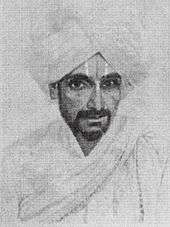
Mangaluru Samachara was the first Kannada news publication as early as 1843 by German missionary Hermann Mögling.[98] Followed by Bhashyam Bhashyachar who is credited with publishing the first Kannada weekly from Mysore "Mysuru Vrittanta Bodhini" in 1859 under the royal patronage of Krishnaraja Wadiyar III.[99] Shortly after Indian independence in 1948, K. N. Guruswamy founded The Printers (Mysore) Private Limited and began publishing two newspapers, Deccan Herald and Prajavani. Presently the Times of India and Vijaya Karnataka are the largest-selling English and Kannada newspapers respectively.[100][101] D. V. Gundappa was notable Kannada journalist, he was awarded third-highest civilian award Padmabhushan in 1974.[102]
List of a few major newspapers:
- Prajavani
- Samyuktha Karnataka
- Kannadaprabha
- Udayavani
- Vijayavani
- Hosa Digantha
- Vishwavani News
- Vijaya Karnataka
Contemporary popular Kannadigas
Spiritual leaders
- Shivakumara Swami, Siddaganga Matha, Tumkur, Karnataka
- Balagangadharanatha Swamiji, Sri Adichunchanagiri Maha Samsthana Math
- Shivamurthy Shivacharya Mahaswamiji
- Taralabalu Jagadguru Brihanmath, Sirigere
- Beerendra Keshava Tarakananda Puri
- Ravi Shankar, Art of Living
Gandhian philosophers
- Kadidal Manjappa former chief minister of Karnataka
- H. Narasimhaiah
- Kollur Mallappa
- B D Jatti - former president and vice president of India
- Mailara Mahadevappa- only person from Karnataka to accompany Gandhiji in Dandi salt sathyagraha/march
- Gudleppa Hallikeri
Modern science and technology
- N. K. Naik - Professor Emeritus at IIT Bombay.
- Raja Ramanna - Indian nuclear scientist and father of the Indian nuclear bomb.
- Dr. M.C. Modi - Ophthalmologist and humanist.
- C. N. R. Rao - Notable Solid-state scientist and chairman of Science Advisory Council of GOI. Recently awarded with India's highest civilian award Bharat Ratna
- K. N. Shankara - Indian space scientist and master in satellite payload technology.
- Shakuntala Devi - Mathematics.
- Vivek Murthy American physician serves as the 19th Surgeon General of the United States.
- Narayan Hosmane - Biochemistry and Cancer research.
- S. K. Shivkumar - Scientist, ISRO telemetry (ISRO), associated with Chandrayaan-1 lunar probe.
- Roddam Narasimha[103] - senior scientist IISc, chairman JNCASR.
- C. R. Rao - Statistics, Mathematician. Professor emeritus at Penn State University.
- Shrinivas Kulkarni - Professor of astrophysics and planetary science at Caltech, United States of America.
- S. Shankar Sastry - Dean of the College of Engineering at the University of California, Berkeley.
- L. S. Shashidhara - Developmental biologist, geneticist and a professor and chair of Biology at Indian Institutes of Science Education and Research (IISER).
- M. Visvesvaraya - Indian scholar and engineer, who also served as the Diwan of Mysore.
Environmentalists
Karnataka is one of the few states which, while a leading contributor for GDP of the country[104] and home for industries, has preserved its forests and wildlife. The evergreen Sahyadri and Western Ghats are home to protected Wildlife of Karnataka. The Kannadiga culture protects and balances Kaadu (forest) and Naadu (state) as can be seen. Although seen scantly still the state enjoys the diversity owing to tribal sects of Soliga, Badaga, Jenu Kuruba, Hakki Pikki, Lambani, Siddis and other inhabitants of forests. See Appiko Chaluvali.
Noted environmentalists include:
- Ullas Karanth (tiger research biologists/zoologist)
- Saalumarada Thimmakka
- Suresh Heblikar
- Poornachandra Tejaswi (ornithologist / littérateur)
- Snake Shyam
- Krupakar-Senani
Current cricketers
Retired cricketers
- Anil Kumble
- Rahul Dravid
- Javagal Srinath
- Gundappa Vishwanath
- Vijay Bhardwaj
- Venkatesh Prasad
- B.S. Chandrashekhar
- E. A. S. Prasanna
- Roger Binny
- Sunil Joshi
- Syed Kirmani
- Sujith Somasunder
- Dodda Ganesh
- David Johnson
Culture
Purana
The Puranas describe the region as Kishkindha in the age of the Ramayana. There is also literary evidence that the region of Mysore was called "Mahisha Mandala" after the mythological demon Mahishasura. Parashurama and Hanumantha are some epic characters to be cited relating to this place. Hanumantha (Hanuman) is said to be born in Kishkindha, Karnataka.
Punya Koti
One of the most popular and acknowledged Jaanapada songs is "Dharani mandala madhyadolage" which narrates an incidence between mother cow and an aggressive tiger in a place called Karnataka.
Vishwa Maanava
Karnataka as now can be viewed as a multicultural state – almost all the religions that can be found in India can be found here and there has been lot immigration as well due to which multi-ethnic diaspora can be seen. As the kingdoms provided a safe centres for development of all cultures we can see a huge diversities from region to region. Even the language and dialects varies from place to place. The language has evolved distinctly in both the backyard (folk/basic/prakrutha) and frontyard (refined and related to Samskrutha/Sanskrit) of the culture. It can be said that the major works of Sanskrit have originated and continues to evolve here. Shringeri, Udupi are some of nerve centres. One of the leading examples include a village near Shivamogga where people speak only Sanskrit till date. Bengaluru being Kannada majority has almost all language speakers of India, and kannadigaru are said to be tolerant and welcoming people.
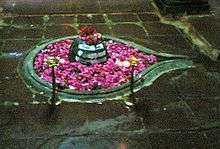
One of the most acknowledged concept is to be a Vishwa Maanava or universal being. In Kuvempu's ideology this has a renowned explanation "Every Child is born as a Vishwa Maanava or a Universal Human. It is we who make him Alpa Maanava or Little Human by putting various constrictions of borders rituals and castes. It hence becomes responsibility of our culture to again make him a Universal Being unbound and free." The Kannadiga culture is known to provide shelter and self-respect to people by owning them and their culture. Two colonies for refugees from Tibet are formed, one near Mundgod and one near Kushalanagara, protecting them from Chinese atrocities. Karnataka has sheltered flood victims of northeastern India like Assam and provided them jobs. One of the easily seen diversity is the surnames which vary from hugely like some may involve names involving a Hindu and Muslim name or having a Hindu Christian name (more found in Mangaluru) or even a Muslim Christian name.[105]
Political sphere
After the Odeyar era who already had established democracy by naming elected representative called Saamantha in southern regions as early as the 19th century, the 1947 partition brought a centre into being under democracy and Karnataka accepted a bicameral legislature. But this was a functionally a failure as there always has been a tug of war from centre and states to an extent that from the 1990s to 2010 there have always been different political parties operating at centre and state. North Karnataka had other problems of getting independence more from Nizams. So there were two spheres. Lack of will and coordination and constant fights have been hallmark of politics which has prevented a regional party/media from arising in the land. Kerala being a neighbour where hugely successful communist ideology in bringing up literacy levels has a backing here and a few naxalite outfits function in Karnataka.
Functional failure of all pillars of democracy even being upper riparian state can be clearly seen in the Kaveri River Water Dispute issue. The failure extended to bureaucracy and Karnataka reached the position of being fourth most corrupt state of India[106] due to political and bureaucratic lobby. Because of this, Lokayukta (see N. Venkatachala) was formed but could not get the required powers to deal with the powerful. In the field of press and journalism P. Lankesh and S. Gurumurthy[107] are some of the noted ones famous for their leftist affiliations.
Horanadu Kannadiga
Horanadu Kannadigas (or non-resident Kannadigas) are Kannadigas who have migrated to another state or country, people of Kannada origin born outside Karnataka, or people of Kannada origin who reside permanently outside of Karnataka. N R Narayana Murthy, speaking at the 2011 World Kannada Conference, opined that Kannadigas who move out of the state are respected everywhere.[108] Although the failure in political arena has reflected in the cultural isolation of emigrants, some of the successful functional bodies include Singara (Singapore),[109] Dehali Kannadiga (New Delhi), Mumbai Karnataka Sangha (Mumbai),[110] Mallige Kannada Balaga (Mauritius),[111] North America Vishwa Kannada Association (NAVIKA) and Association of Kannada Kootas of America (AKKA) in the United States have promoted cultural involvement[112] through events such as Kannadotsava. The Kannadiga diaspora are found all over the world, mainly in the USA, the United Kingdom, Singapore, the UAE.[113][114][115][116][117][118]
Unification of Karnataka
First and Second World Wars
After occupying Mysore, British had baited 8 acres & a Rs 75 salary for battalions for World Wars from Karnataka.[119] Kannadiga regiments got disbanded after world war 2 as per Imperial War Museum[120][121] records, as historians still debate about exclusion of revolts from south of Vindhyas against British Indian Army.[122] From September 1939 until August 1945, recruitment was done at Regimental Centre at Belagavi for the Madras Regiment, the Mahar Regiment, and the Lingayat Regiment.[123] In 2017, a panel has been setup to look into legalities of separate flag for Karnataka.[124]
The post-1947 scene
During the period of British rule, state of Karnataka as it stands today did not exist. Areas that today comprise Karnataka were under as many as 20 different administrative units with the princely state of Mysore, Nizam's Hyderabad, the Bombay Presidency, the Madras Presidency and the territory of Kodagu being the most important ones. In effect, nearly two-thirds of what is now Karnataka fell outside the rule of the Wodeyar kings of Mysore. In addition the proposed state had six neighbours — Goa, Maharashtra, Andhra Pradesh, Tamil Nadu, Kerala — and all had Kannadigas along the borders overlapping these regions.
What this meant for the Kannadigas in these regions was that they were reduced to linguistic minorities wherever they were. Kannadigas in the Hubli-Karnataka region for example, came under the rule of the Bombay presidency where Marathi was the official language. Those in the Hyderabad-Karnataka region came under the Nizam's rule where Urdu ruled, while in Mysore Kingdom, Kannada was the official language.
It was in this backdrop that the movement that first started as a protest against linguistic oppression, soon morphed into one that began demanding a separate state be created consolidating all Kannada speaking regions. This was essentially a movement that was spearheaded by the poets, journalists and writers and was called the Ekikarana or 'Unification' movement. India gained independence in 1947. The joy of independence soon gave way to disappointment as the new government started dragging its feet on Karnataka Ekikarana movement. Kannada speaking areas now got grouped under five administrative units of the Bombay and Madras provinces, Kodagu, and the princely states of Mysore and Hyderabad. The Akhila Karnataka Ekikarana Parishat met in Kasargod and reiterated the demand for a separate state for Kannadigas.
The ratification in parliament of the recommendations of the Fazal Ali Committee brought joy to the Kannadiga population that now was merged under the state of Mysore.
On 1 November 1973, under Devaraj Urs as chief minister, Mysore state was renamed as Karnataka since it was felt that Karnataka was more 'inclusive' of all the other regions of Karnataka than the name Mysore.
Kannada unification organisations currently active include:
- Karnataka Vidyavardhaka Sangha
- Karnataka Ekikarana Samithi
- Karnataka Rakshana Vedike
- Kannada Chalavali Vatal Paksha
Kannada ethnic flag

The Kannada ethnic flag is a banner with two horizontal stripes, yellow on top and red on the bottom. The flag neither is official nor represents any legendary empire but has become accepted in recent times representing a symbol of culture and welfare. The flag was first conceived by Ma Ramamurthy, a Bangalore-based writer, journalist and social activist, often considered as a commander of Kannada movement in 1960s.
See also
- Kannada film industry
- Kannada language
- Kannada literature
- Kannada poetry
- Karnataka
- Karnataka literature
- List of people from Bangalore
- List of people from Karnataka
- List of people of North Karnataka
- North Karnataka
- Sanganakallu
- Siribhoovalaya - a unique literary work[125]
References
- Statement 1 : Abstract of speakers' strength of languages and mother tongues - 2021
- Kannada people at Ethnologue (21st ed., 2018)
- "Population by religion community – 2011". Census of India, 2011. The Registrar General & Census Commissioner, India. Archived from the original on 25 August 2015.
- Kannada masculine Kannaḍiga, feminine Kannaḍati, plural Kannaḍigaru
- "The Karnataka Official Language Act" (PDF). Official website of Department of Parliamentary Affairs and Legislation. Government of Karnataka. Retrieved 29 June 2007.
- "Encyclopedia of World Cultures - Canarese, Kannadiga". Encyclopedia.com. Retrieved 17 September 2013.
- http://www.ciil-lisindia.net/Kannada/Kan_demo.html
- "Kannadigas TN's 3rd biggest group | Bengaluru News - Times of India".
- "Indiaspeak: English is our 2nd language". The Times of India. 14 March 2010. Retrieved 12 February 2013.
- "Kannadigas outnumber Malayalis 2:1 in Tamil Nadu". The Times of India. 15 April 2008.
- "Kanarese | Meaning of Kanarese by Lexico".
- "Census of India Website : Office of the Registrar General & Census Commissioner, India". censusindia.gov.in. Retrieved 16 March 2020.
- Chandravalli
- "Kannada inscription at Talagunda may replace Halmidi as oldest". 12 January 2017.
- Thapar, Romila (2003), p. 433, The Penguin History of Early India, From Origin to 1300 AD., 2003, Penguin, New Delhi, ISBN 0-14-302989-4
- Kamath (2001), pp. 84, 90
- Moraes (1931), p 4
- Purava HaleGannada or Pre-old Kannada was the language of Banavasi in the early Christian era, the Satavahana and Kadamba eras (Wilks in Rice, B.L. (1897), p 490
- Narasimhacharya (1988), p 68
- Cousens (1996), p15
- Mahalingam in Adiga (2006), p 130
- Adiga (2006), p. 134
- Their territory included modern Tumkur, Chitradurga, Kolar, Bellary and Bangalore districts. Chopra et al. (2003), part 1, p. 163
- Adiga (2006), p. 142
- They were an Andhra dynasty who ruled over Kurnool, Cuddappah in the 10th century. There inscriptions are in Telugu and Kannada. Chopra et al. (2003), part 1, p. 163
- Also known as the Kempegowda family, builders of modern Bangalore-Kamath (2001), pp. 240–241
- Two coins of the Hangal Kadambas exist, one with the Kannada inscription Saarvadhari and other with Nakara. They are preserved in the Royal Asiatic Society and Indian Historical Research Institute, Mumbai - Moraes (1931), p 385
- Kamath (2001), pp. 143-144
- The coins of the Kadambas of Goa are unique in that they have alternate inscription of the king's name in Kannada and Devanagari in triplicate. This shows that the native vernacular of the Goa Kadambas was Kannada. Moraes (1931), p 384
- Kamat, Suryanath U., (2001), p.8, A Concise history of Karnataka from pre-historic times to the present, Jupiter books, MCC, Bangalore, 2001 (Reprinted 2002), OCLC: 7796041
- Bose, Manilal (1998), p.28, Social and Cultural History of Ancient India, Concept Publishing Company, ISBN 81-7022-598-1
- Makhan Jha, (1997), pp52-53, Anthropology of Ancient Hindu Kingdoms: A Study in Civilizational Perspective, M.D. Publications Pvt. Ltd, ISBN 81-7533-034-1
- S.R. Bakshi, S. Gajrani, Hari Singh (2005), p.254, Early Aryans to Swaraj, Sarup & Sons, ISBN 81-7625-537-8
- Sengupta, Nitish K (2011), p50, Land of Two Rivers: A History of Bengal from the Mahabharata to Mujib, Penguin Books, Chapter:The Sen Dynasty, ISBN 9780143416784
- Desai, Pandurang Bhimarao (1970), p.213, A History of Karnataka: From Pre-history to Unification, Kannada Research Institute, Karnatak University, OCLC:203297
- Mishra, Jayakanta in Ayyappa Paniker (1997), p.280, p.289, Medieval Indian Literature: Surveys and selections, Sahitya Akademi, ISBN 81-260-0365-0
- Pollock, Sheldon (2006), p.417, note.79, The Language of the Gods in the World of Men: Sanskrit, Culture, and Power in Premodern India, University of California Press, ISBN 9780520260030
- Parishad, Bihar Purāvid (1981). "The Journal of the Bihar Purävid Parishad, Volumes 4-5". p. 414. Retrieved 26 January 2017.
- Sinha, Chandreshwar Prasad Narayan (1979). "Mithila Under the Karnatas, C. 1097-1325 A.D". p. 55. Retrieved 26 January 2017.
- Choudhary, Radhakrishna (1970). "History of Muslim rule in Tirhut, 1206-1765, A.D." p. 28. Retrieved 26 January 2017.
- "The Journal of the Bihar Research Society, Volume 46". 1960. pp. 22–25. Retrieved 26 January 2017.
- "Publications, Volume 33". 1935. p. 193. Retrieved 26 January 2017.
- Altekar in Kamath (2001), p. 73
- Altekar 1934, pp. 21–22
- Keay (2000), p 170
- The Eastern Chalukyas were originally of Kannada stock who later encouraged Telugu Dr. K.S.S. Seshan, University of Hyderabad. "APOnline-History of Andhra Pradesh-ancient period-Eastern Chalukyas". Revenue Department (Gazetteers), Government of Andhra Pradesh. Tata Consultancy Services. Archived from the original on 6 December 2006. Retrieved 12 November 2006.
- Shrinivas Ritti and A.V. Narasimha Murthy in Kamath 2001, p. 137
- Seuna coins carry Kannada legends from the beginning of their rule (O.P. Varma in Kamath 2001, p. 137)
- Masica, Colin P. (1991). "Subsequent Spread of Indo-Aryan". The Indo-Aryan Languages. Cambridge University Press. p. 45. ISBN 0-521-29944-6.
- Majority of the Seuna inscriptions are in Kannada and during the formation of the kingdom, the Nasik-Ahamadnagar region (Seuna Desa) was a Kannada territory (Kamath 2001, p. 137)
- A Kannada dynasty may have been created in Berar under the rule of Badami Chalukyas, (Altekar 1934, pp. 21–22)
- The Gujarat Rashtrakutas signed even their Sanskrit records in Kannada because that was the language of the place of their origin (D.R. Bhandarkar in Kamath 2001, p 73)
- The Gujarat Rashtrakutas would not have signed their inscriptions in Kannada language in far away Gujarat unless they were Kannadigas (Altekar 1934, pp 21–22)
- B.P. Sinha in George E. Somers, Dynastic History of Magadha, p. 214, Abhinav Publications, 1977, New Delhi, ISBN 81-7017-059-1
- Sen (1999), p282
- Majumdar, R. C. (1977), Ancient India, Motilal Banarsidass Publishers, p. 320, New Delhi, ISBN 81-208-0436-8
- Harish Ramaswamy (2007). Karnataka Government and Politics. Concept Publishing Company. pp. 398–399. ISBN 978-81-8069-397-7.
- "Group of Monuments at Hampi/Hampei". World Heritage. Retrieved 20 December 2006.
- "And India's 7 wonders". The Times of India. 5 August 2007.
- The Chaalukyun magnificence Archived 22 November 2007 at the Wayback Machine
- "Badami Cave Temple". Archived from the original on 1 February 2009. Retrieved 2 March 2009.
- "Aihole Temple relocation". The Hindu. 20 February 2007. Retrieved 17 September 2013.
- "Message with Long Life: Indian Inscriptions". Dr. Jyotsna Kamat. Retrieved 5 May 2009.
- "Basavakalyan getting facelift". The Hindu. 8 August 2007.
- "Kalyani Chalukyan temples". Templenet. Retrieved 17 September 2013.
- Haridasa Contribution to Kannada Literature
- Nilakanta Sastri, K.A. (2002) [1955]. A history of South India from prehistoric times to the fall of Vijayanagar. New Delhi: Indian Branch, Oxford University Press. ISBN 0-19-560686-8.
- Sharma, B.N.K (2000) [1961]. History of Dvaita school of Vedanta and its Literature. Bombay: Motilal Banarasidass. ISBN 81-208-1575-0.
- OurKarnataka.com(OKC). "History of Karnataka - The Haridasa Movement". Ourkarnataka.com. Retrieved 17 September 2013.
- "The Hindu Online". Hinduonnet.com. 10 February 2005. Archived from the original on 6 December 2012. Retrieved 17 September 2013.
- "Ornamentation in South Indian Music and the Violin By Gordon N. Swift" (PDF). Archived from the original (PDF) on 17 June 2013. Retrieved 17 September 2013.
- Thielemann, Selina (2000). The Music of South Asia. New Delhi: A. P. H. Publishing Corp. p. 521. ISBN 978-81-7648-057-4.
- OurKarnataka.com(OKC). "YAKSHAGANA - The music of celestial beings". Ourkarnataka.com. Retrieved 17 September 2013.
- "Bharat Ratna for Vocalist Pandit Bhimsen Joshi". Rediff. Retrieved 21 February 2009.
- "Padma Awards". Ministry of Communications and Information Technology (India). Retrieved 16 May 2009.
- "About C. Aswath". Caswath.com. Archived from the original on 23 July 2011. Retrieved 17 September 2013.
- Manohar Laxman Varadpande (1992). History of Indian theatre, Volume 2. Abhinav Publications. p. 311. ISBN 978-81-7017-278-9.
- "Karnataka Folk Theatre - Imitation of the Divine". Indiaprofile.com. Retrieved 17 September 2013.
- Special Correspondent (20 June 2011). "Harikatha sapthaha from today". The Hindu. Retrieved 17 September 2013.
- News, Express. "20,000 devotees to get together for Shivratri". The New Indian Express. Retrieved 17 September 2013.
- Auckland Kannadigas enjoyed Harikathe on the occasion of 'Dasara' Archived 29 September 2011 at the Wayback Machine
- "Vasanthahabba from February 2". The Times of India. The Times Internet Ltd. 29 January 2002.
- Kavita Mandana. "A spring in their step". Online Edition of The Deccan Herald, dated 2004-01-17. The Printers (Mysore) Private Ltd. Archived from the original on 14 May 2014. Retrieved 12 August 2007.
- "About Bengaluru Habba". Bengaluruhabba.co.in. 22 January 2012. Retrieved 17 September 2013.
- Jaanapada Jaatre, The Hindu
- Soliga welcome planned for Kalam, The Hindu
- Details regarding Dasara Wrestling competition held in Mysore is provided by Shankar Bennur. "Dasara wrestling to offer 'thunder' bouts". Online Edition of The Deccan Herald, dated 2005-09-30. 2005, The Printers (Mysore) Private Ltd. Archived from the original on 14 May 2014. Retrieved 4 April 2007.
- Culinary Traditions of Medieval Karnataka: The Soopa Shastra of Mangarasa III, p.9-22
- Raja M - 'The dosa, like most other south Indian culinary exports, is often linked to Udupi, a small temple town in the state of Karnataka'. "India's new offering to curry Western flavor". Asia Times, 24 June 2004. Retrieved 23 August 2010.CS1 maint: multiple names: authors list (link)
- "Karnataka Khadi Gramodyog Samyukta Sangh (Federation), Hubli". Khadifederation.com. Retrieved 17 September 2013.
- "The living bard". Deccan Herald. October 2011.
- Prasad (19 September 2011). "ಡಾ. ಚಂದ್ರಶೇಖರ ಕಂಬಾರರಿಗೆ ಜ್ಞಾನಪೀಠ ಪ್ರಶಸ್ತಿ". Thatskannada.oneindia.in. Retrieved 17 September 2013.
- Ramanujan, A. K. (1973), Speaking of Śiva Harmondsworth: Penguin, p. 11, ISBN 0-14-044270-7
- R.S. Mugali (2006), The Heritage of Karnataka, pp. 173–175 ISBN 1-4067-0232-3
- Jnanpith for Kambar, The Hindu
- "Government establishes Beary Academy". The Hindu. Chennai, India. 25 August 2007.
- Hermann Mögling's contribution to the Kannada literature is mentioned by Shrinivas Havanur. "Herr Kannada". Online Edition of The Deccan Herald 2004-01-18. 1999 The Printers (Mysore) Private Ltd. Archived from the original on 14 May 2014. Retrieved 1 May 2007.
- Bellary Shamanna Kesavan (1988) - History of Printing and Publishing in India: Volume 2, p.48
- Shuma Raha (19 November 2006). "Battleground Bangalore". The Telegraph.
- "Times Group acquires Vijayanand Printers". Online Edition of The Times of India dated 2006-06-15. Times Internet Limited. Retrieved 8 June 2007.
- "Padma Bhushan Awardees". Archived from the original on 9 August 2014. Retrieved 17 January 2017.
- "Science centres planned at taluk and district levels". The Hindu. 16 September 2005. Retrieved 17 September 2013.
- "GDP contribution". Kar.nic.in. Archived from the original on 14 March 2012. Retrieved 17 September 2013.
- "Archived copy". Archived from the original on 17 July 2017. Retrieved 23 July 2017.CS1 maint: archived copy as title (link)
- "Bureaucratic Corruption". Rediff.com. Retrieved 17 September 2013.
- S Gurumurthy of The New Indian Express Archived 8 October 2007 at the Wayback Machine
- Belgaum, 11 March, DHNS (11 March 2011). "NRN opens heart to Kannadigas". Deccan Herald. Retrieved 17 September 2013.CS1 maint: multiple names: authors list (link)
- Singara - Kannada Sangha (Singapore) Archived 10 February 2009 at the Wayback Machine
- "Karnataka Sangha Mumbai". Karnataka Sangha Mumbai. Retrieved 17 September 2013.
- "Mallige Kannada Balaga: Spreading Fragrance of Karnataka in Mauritius". Daijiworld.com. Retrieved 17 September 2013.
- TNN (5 January 2002). "AKKA to host world Kannada meet in US from 2 September". The Times of India.
- "NRI Forum Karnataka".
- "Navika".
- http://www.akkaonline.org/
- "Singara".
- "ಕನ್ನಡ ಸಂಘ ಸ್ಯಾಕ್ರಮೆಂಟೊ | Kannada Sangha of Sacramento".
- "KKK Club Membership | Kuwait Kannada Koota".
- https://pbs.twimg.com/media/BsmVIxXCQAAmPBJ.jpg
- Raghu Karnad [@rkarnad] (15 July 2014). "#Kannadigas in #WW2! Joining up for the swag (8 acres & a Rs 75 salary). A full Lingayat battalion was raised in '41" (Tweet) – via Twitter.
- "There is a Lot in a Name".
- "Historians pick Vizag revolt as first war of Independence". 20 July 2017.
- "Lingayat Battalion".
- "Karnataka demands state flag, sets up panel to study legal provisions". 18 July 2017.
- Archived 28 September 2007 at the Wayback Machine
Further reading
- John Keay, History of India, 2000, Grove publications, New York, ISBN 0-8021-3797-0
- Suryanath U. Kamat, A Concise history of Karnataka from pre-historic times to the present, Jupiter books, MCC, Bangalore, 2001 (Reprinted 2002) OCLC: 7796041
- Dr. Romila Thapar, The Penguin History of Early India, From Origin to 1300 AD., 2003, Penguin, New Delhi, ISBN 0-14-302989-4
- Altekar, Anant Sadashiv (1934), The Rashtrakutas And Their Times; being a political, administrative, religious, social, economic and literary history of the Deccan during c. 750 AD to c. 1000 AD, Oriental Book Agency, Poona, OCLC 3793499
- K.A. Nilakanta Sastri, History of South India, From Prehistoric times to fall of Vijayanagar, 1955, OUP, New Delhi (Reprinted 2002), ISBN 0-19-560686-8
- R. Narasimhacharya, History of Kannada Literature, 1988, Asian Educational Services, New Delhi, Madras, 1988 ISBN 81-206-0303-6.
- Malini Adiga (2006), The Making of Southern Karnataka: Society, Polity and Culture in the early medieval period, AD 400–1030, Orient Longman, Chennai, ISBN 81-250-2912-5
- George M. Moraes (1931), The Kadamba Kula, A History of Ancient and Medieval Karnataka, Asian Educational Services, New Delhi, Madras, 1990 ISBN 81-206-0595-0
- Rice, B.L. [1897] (2001). Mysore Gazetteer Compiled for Government-vol 1. New Delhi, Madras: Asian Educational Services. ISBN 81-206-0977-8.
- Chopra P.N., Ravindran T.K., Subrahmanian N. (2003), History of South India (Ancient, Medieval and Modern), Chand publications, New Delhi ISBN 81-219-0153-7
- Cousens, Henry, (1926), The Chalukyan Architecture of Kanarese Districts, Archaeological Survey of India, New Delhi, OCLC 37526233
- Sen, Sailendra Nath (1999) [1999]. Ancient Indian History and Civilization. New Age Publishers. ISBN 81-224-1198-3.
External links

